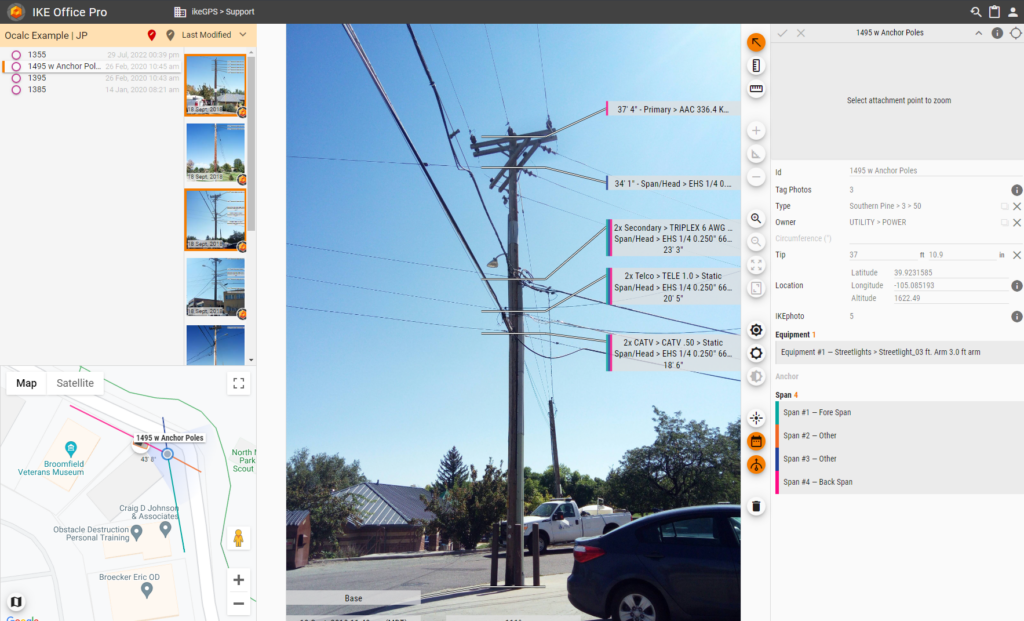The PoleOS™ Company
Cloud-Based Workflows are the Key to an Efficient Joint-Use Process
For communications companies seeking to attach their broadband cables to the electric grid’s existing infrastructure via the joint-use process, speed is of the utmost importance.
The faster a communications company can attain a utility-approved joint use permit, the faster it can attach to the utility’s poles and realize the financial rewards of expanding broadband’s reach across the country.
For the electric utilities who, in most cases, own and are responsible for the poles to which communication cables are attached, the integrity of the pole itself and the safety of the public are paramount.
That’s because nothing is more important to a utility than delivering safe, reliable electricity to its customers–a mission that is becoming increasingly challenging in a time of extreme weather events that regularly threaten the electric grid’s integrity.
A pole whose integrity has been compromised because it is unable to support additional cables may not withstand a weather event and is therefore a potential liability for the utility.
An inefficient workflow can be the enemy of both a speedy and safe joint-use project.
Consider a communication company or engineering company contracted by the communication company, that is collecting field data via traditional methods.
These methods can be pen and paper with a Hastings Stick (about as traditional as it gets but still in practice) or digital in nature with cameras and tablets.
In either case, it can take a fair amount of time for the acquired data to make its way to a location where it can be uploaded and pole load analysis can then take place.
Fielders often collect data in remote locations and subsequently have long commutes back to office locations with strong enough internet signals to support the upload.
Time is money when it comes to successful broadband expansion. The clock is always ticking and every second counts. The longer it takes to upload data collected in the field, the longer it takes to conduct pole load analysis and obtain a joint-use permit.
As I’ve discussed in previous writings that relate to my time in the field and office working for communications companies, mistakes get made by both fielders and analysts seeking to obtain an approved joint-use permit as quickly as possible.
The problem for utilities is that these mistakes can easily get lost in the mounds of data that have been collected and recorded then buried in the utility’s geographic information system (GIS) or main server.
So often, the utility is unknowingly sitting on bad data that, like a rotten apple in the bottom of a barrel, can’t be easily spotted or verified yet has the potential of being quite the spoiler if a pole that passed load analysis fails due to overload and causes damage or injury.
Here is where cloud-based workflows can be a digital savior for both parties of the joint-use process.
Cloud-based workflows allow data acquired in the field to be uploaded efficiently and wirelessly to a location where it can be accessed and assessed by both the communications company and the utility.
Cloud-based workflows, above all, allow the data to be viewed and verified by both parties, allowing for the utility to ensure that what the communications company is proposing is correct.


Cloud-based systems such as IKE Office Pro include a rugged device that allows data acquired in the field to be quickly uploaded to purpose-built software so it can be accessed and analyzed. If desired, the data can then be exported to existing native systems.
Files are easily shareable, unlike when data is stored on a SIM card or hard drive and then uploaded manually. Both parties have access to the data and can edit the data as needed. Both parties also have access to the records and can pull data through their application programming interface (API) to the platform of their choice.
Many larger utilities have a large, complex, and sophisticated internal pole record database. An ideal cloud-based workflow system doesn’t seek to replace this large database. Rather, it complements it.
IKE’s Office Pro is that kind of system. Office Pro includes the IKE device which captures field data and then uploads it via the cloud to the Office Pro software where it can live permanently if desired or temporarily until the joint-use process is complete.

Key with IKE’s or other systems like it is that it is easy for the communications company to upload the data acquired in the field and then it is just as easy for the utility to pull the data via an API and ingest it into their own native system.
Systems such as IKE Office Pro can become the most important piece of the joint use process because they facilitate easy and simultaneous use of the pole data by both the communications company and the utility.
The electric grid and 5G networks were conceived by thinkers who always had their heads in the clouds in order to dream up a better way to the future.
For an efficient joint-use process that’s a win-win for broadband expansion and grid infrastructure integrity, your head shouldn’t be in the cloud.
Your data and workflow should.

About the author:
Spencer Hankin is a Senior GIS Manager for ikeGPS. He has worked in every aspect of OSP aerial engineering including fielding poles in remote areas, building PLAs, managing field teams, and overseeing fiber design projects from start to finish as a lead OSP engineer. He holds an undergraduate degree in Geology from the University of Colorado and an MBA from the University of Redlands with a concentration in Location Analytics.
Learn how IKE Office Pro is the hub of a productive joint-use process.
Explore IKE Office ProThe latest from the IKE Wire
Understanding the NESC rules for streetlights in the Communication Worker Safety Zone
In an earlier blog post, we explored the Communication Worker Safety Zone – its...
Read MoreVideo Chat: Challenges and Opportunities for Power Delivery Leaders (Part 2)
Overview Energy industry expert and author, Peter Kelly-Detwiler, Dennis Elsenbeck, h...
Read MoreIntroducing PolePilot™: Intelligent automation for utility pole analysis
Analyzing distribution pole imagery is traditionally a manual, time-consuming process...
Read MoreSubscribe to the IKE Wire
Get the latest insights on data acquisition and structural analysis from the ikeGPS experts.
